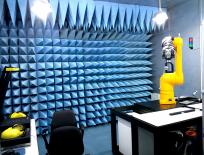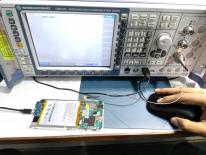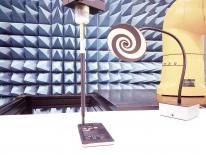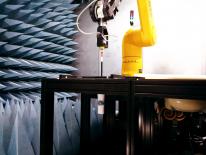
SAR Testing on cDASY6
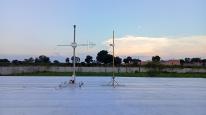
Horn Antenna Calibration at OATS
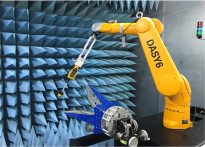
NARDA SRM Calibration
RF Conformance Testing
EM Field Measurement
Spectrum Analyser Calibration
SAR testing of Smart Watch
BACKGROUND
BNNSPEAG is a joint venture between BNN Communication Engineers, India and Schmid & Partner Engineering AG, Switzerland and has been in operation since 2012.
The company operates a state of the art, high precision RF test and calibration laboratory (NABL accredited) in Delhi NCR, India. The laboratory has advanced test and calibration facilities for the following:
(i) SAR Testing and Measurements: Head and body SAR (Specific Absorption Rate) testing and measurements for mobile phones, PDA's, laptops and all other RF devices used in close proximity to human body. The lab is equipped with the latest cDASY8 SAR measurement system from SPEAG for compliance testing in accordance with all international (EU / US - FCC) standards. Additionally the cSAR3D vector array fast SAR system complements the cDASY8 for quick compliance, as well as pre-compliance testing.
The Lab has WUmmWV2 probe from Speag (0.75-110GHz) to undertake undertake 5G compliance testing as per IEEE 63195(draft)
(Application Note on 5G testing).
(ii) Antenna Calibration: The Laboratory has recently been 17025 accredited (NABL) to undertake Antenna Calibration at its newly constructed Open Area Test Site at Village Mehmoodpur, Loni, Ghaziabad under standards ANSI C63.5:2017, CISPR 16-1-6:2022, SAE ARP 958.
(iii) EM Field Measurements Calibration: The Precise measurement of electric / magnetic fields emanating from electronic / electrical equipment. The lab is equipped with the DASY52 NEO robot scanning system for precise measurement of EM fields from devices in accordance with the BS/EN 62311:2008 standard.
(iv) RF Conformance Testing: RF Measurements for GSM, (E) GPRS, WCDMA, HSPA, LTE (FDD / TDD) in accordance with the 3GPP Technical Specifications. The Lab is equipped with the CMW500 Base Station Simulator
to carry out RF measurements in accordance with the 3GPP technical specifications.
(v) RF Calibration: Calibration of spectrum analyzers, multiband scanners / receivers, test mobiles phones for frequency (Hz), attenuation (dB) and power level (dBm). NABL accrreditation has been applied for and final audit planned in Jun 2019.
(vi) Electric Field Calibration: Calibration of EMF radiation hazard meters (NARDA /R&S/ Anritsu/ Keysight) for parameter electric field (V/m).
(vii) Safety Evaluation of Medical Implants. Close collaboration with the IT'IS Foundation, Switzerland in Safety Evaluation of Medical Implants.
BNNSPEAG laboratory follows a management system which is compliant with the ISO/IEC 17025 standard. BNNSPEAG is accredited with National Accreditation Board in India for Testing & Calibration Laboratories, India (NABL) for
(a) SAR testing of Mobile Phones
(b) Calibration of Radio Electric/ Electromagnetic Field Hazard Meters and Warning meters and Warning indicators.
(c) Calibration (both on site and at its permanent facility) of Spectrum Analysers, Signal Generators, GNSS generators, Attenuators, Receivers (upto 18GHz)
(d) Calibration of EMC Antennae like Bi-conical, LPDA, Bi-Log, Horn at its Open Area Test Site at Village Mehmoodpur and Loop, Monopole at its laboratory facilities at Sahibabad.
BNNSpeag can perform testing, calibration and certification of telecom products under the TEC MTCTE scheme (ILAC arrangement) for SAR testing and certification of mobile handsets and devices.
How is SAR Measured
The SAR is measured by placing it against a representation of a human head (a "SAR Phantom") in a talk position. The SAR value is then measured at the location that has the highest absorption rate in the entire head, which in the case of a mobile phone is often as close to the phone's antenna as possible. Measurements are made for different positions on both sides of the head and at different frequencies representing the frequency bands at which the device can transmit. Depending on the size and capabilities of the phone, additional testing may also be required to represent usage of the device while placed close to the user's body and/or extremities. Various governments have defined maximum SAR levels for RF energy emitted by mobile devices:
SAR Limits in India and Abroad
United States: FCC requires that phones have a SAR level at or below 1.6 watts per kilogram (W/kg) taken over the volume containing a mass of 1 gram of tissue that is absorbing the most signal.
European Union: CENELEC specify SAR limits within the EU, following IEC standards. For mobile phones, and other such hand-held devices, the SAR limit is 2 W/kg averaged over the 10 g of tissue absorbing the most signal (IEC 62209-1).
India: Switched from the EU limits to the US limits for mobile handsets in 2012. Unlike the US, India will not rely solely on SAR measurements provided by manufacturers; random compliance tests are done by a government-run Telecommunication Engineering Center (TEC) SAR Laboratory on handsets and 10% of towers.
Setting up SAR Laboratory in India
Please contact our partners BNN Communication Engineers

